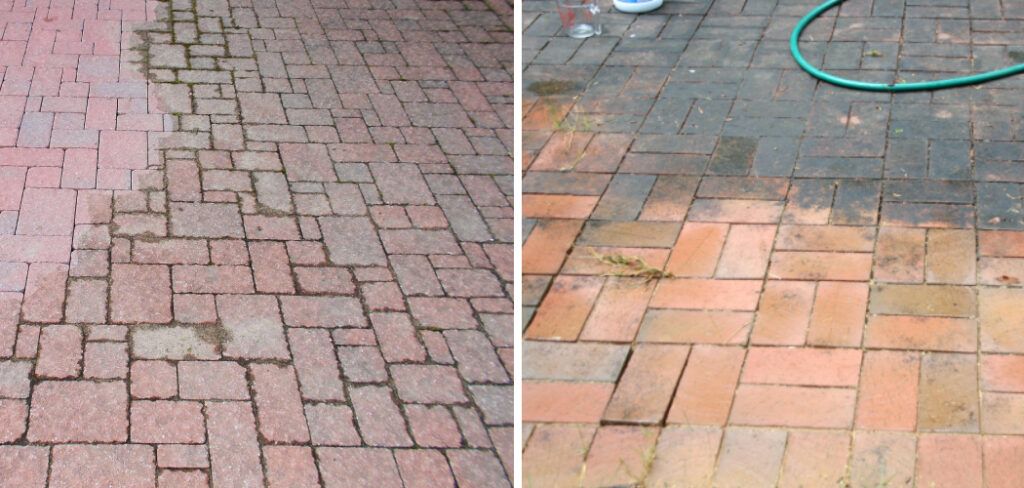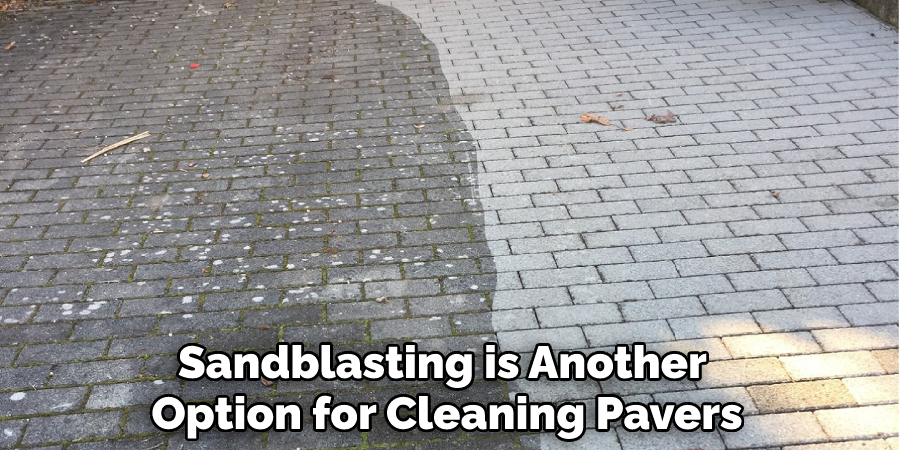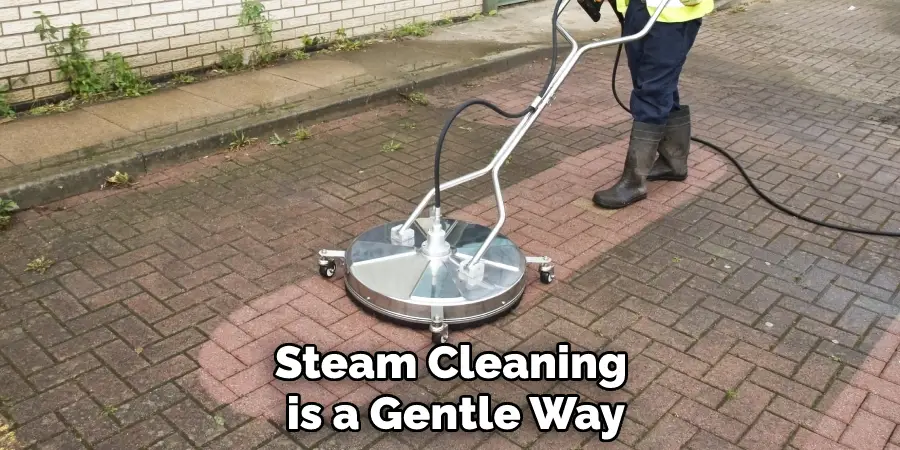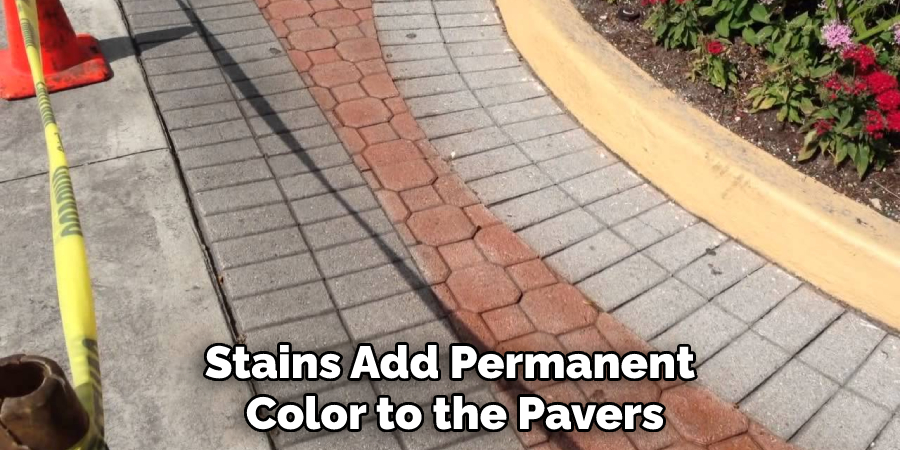Are you looking for ways to liven up your outdoor space with a few simple changes? Does your space feature pavers that could use some sprucing up? Whether yours is stone, concrete, or another type of material, you can easily brighten and eliminate any dullness from those tired pavements.

There are a number of creative approaches available to help add color and texture without having to replace them together. In this post, we’ll explore easy tips and tricks on how to brighten dull pavers quickly and inexpensively. So if you’re ready to get started, let’s take a look at what you need to do!
Why Do My Pavers Look Dull?
Pavers may look dull for a variety of reasons. Weathering and UV exposure can cause discoloration, as can dirt and debris buildup. In addition, efflorescence – the white chalky powder that often forms on surfaces made of brick or concrete – can make pavers appear dull and dingy. Algae and mildew infestations can also cause pavers to look lackluster.
No matter the cause, taking steps to brighten dull pavers is the best way to restore their original beauty. Fortunately, there are a variety of methods available for restoring sparkle and shine to your pavers. Using these easy techniques, you can bring life back into your outdoor spaces.
Be sure to use a light-pressure washer or power broom to remove the dirt without damaging the paver surface. If you don’t have access to these tools, a stiff, bristled brush and some elbow grease will do the trick too.
Once the pavers are cleaned, you can begin work on restoring their shine.
Depending on which type of material your pavers are made from – brick, concrete, stone – different steps should be taken in order to achieve optimal shine and brightness. For brick and concrete surfaces, you can apply a paver sealing sealer.
10 Methods How to Brighten Dull Pavers
1. Pressure Washing
One of the quickest and easiest ways to brighten up dull pavers is to pressure wash them. Pressure washing will remove any dirt, grime, or other debris that may be on the surface of the pavers and will leave them looking like new.

Make sure to use a mild detergent mixture in the pressure washer to ensure that the pavers are not damaged during the cleaning process. If you are unsure about the pressure settings, it’s best to err on the side of caution and use a lower setting.
2. Scrubbing
If pressure washing is not an option, then scrubbing the pavers with a stiff brush and some soapy water can also be effective. Be sure to rinse the pavers well after scrubbing to remove all of the soap residues. Depending on the amount of dirt and buildup, it may take more than one pass with a scrub brush to get your pavers looking as good as new.
If the stains are still present, you may want to use a commercial paver cleaning product for tougher stains. After scrubbing and rinsing the pavers, you can apply a sealant to help protect them from future dirt build-up.
3. Sandblasting
Sandblasting is another option for cleaning pavers that are very dirty or have tough stains. To use this method, you’ll need to rent special sandblasting equipment that is designed specifically for cleaning pavers. It works by using a high-pressure flow of extremely fine sand or other abrasive material to remove dirt and grime from the surface of the paver.

This can be an effective way to both clean and lighten the color of your pavers. However, it can also cause damage to the paver if not done correctly, so make sure you are familiar with the guidelines before proceeding. Once completed, you should seal your pavers with a sealant to help protect them from future wear and tear.
4. Acid Washing
Acid washing is a more aggressive method of cleaning pavers and should only be done by professionals. This method involves using a powerful acid to break down dirt, grime, and buildup from the pavers. After the acid is applied, it must be flushed with water and neutralized with a mild alkaline.
The result is an even brighter appearance for your pavers that will last for many years.
However, you should take caution when using this method as it can cause damage to the pavers or surrounding areas if not done correctly.
Additionally, you should wear protective gear while acid washing your pavers to guard against any potential harm that may come from contact with the acid.
5. Steam Cleaning
Steam cleaning is a gentle way to clean pavers and is safe for most types of paver materials. It can be done with a pressure washer, or you can hire a professional steam cleaning service. The high-pressure water spray blasts away dirt, grime, and other debris from the surface of the pavers.

This method is ideal for light maintenance and removing mildew or moss growths on top of pavers. However, it is not suitable for removing stubborn stains, as the pressure of steam cleaning may damage the pavers. It is important to note that any sealer on your pavers will be removed with this process, so you should reseal the pavers after steam cleaning.
6. Painting
If the pavers are in good condition but just need a new look, painting them may be an option. Be sure to use paint that is specifically designed for use on outdoor surfaces such as concrete or stone. For the best results, be sure to use a primer before painting and multiple coats of paint. Allow each coat to dry completely before applying the next one.
When finished, seal the pavers with a clear sealant for added protection against the weather. With proper care and maintenance, painted pavers can last for many years. Although not all types of pavers may be suitable for painting, they can often be an effective way to brighten up dull pavers.
7. Staining
Staining is another way to change the look of pavers without having to paint them. Stains add permanent color to the pavers, but they don’t block out any of the original texture or pattern.
Staining is a good option if you want to change up the look without losing any of the natural beauty of your paving stones. It’s also one of the easiest ways to brighten dull pavers. All you need is the right type of stain and some water.

Make sure to choose a stain that is made specifically for outdoor use so that it will last in all weather conditions. You can find stains in several colors, so you’ll have plenty of options to work with. To apply the stain, start by mixing it with a small amount of water. Then, use a brush or roller to spread the mixture over the pavers evenly.
8. Engraving
Engraving is a process whereby designs are etched into the surface of the pavers using a variety of tools. This can be an effective way to add interest and dimension to otherwise plain pavers. If a more subtle look is desired, the design can be etched lightly and either left as natural stone or filled in with paint or sealant.
For a more dramatic effect, deeper etching and bolder designs are possible. Engraving can be done by professionals or do-it-yourselfers; however, it is important to take safety precautions when using power tools such as grinders and sandblasters.
Proper safety equipment, such as goggles and gloves, should always be used to protect the operator’s eyes, lungs, and skin. Additionally, it is important to check with local authorities regarding appropriate dust control measures for sandblasting operations in residential areas.
9. Adding Decorative Accents
Adding decorative accents such as stones, shells, or glass beads can also help to brighten up dull pavers. These accents can be added to the surface of the pavers using adhesive, or they can be embedded into the wet concrete before it dries. Decorative accents can also be used to create a pattern or design on the paving surface.
They will add texture and color to an otherwise dull-looking patio or walkway. Be sure that any materials added adhere to the manufacturer’s instructions for installation and maintenance so they remain beautiful for years to come.
Conclusion
Pavers can greatly improve the look of any home, but they need to be kept clean and bright to really make an impact. Thankfully, there are a few simple ways to achieve this.
By following the tips above, you’ll have no trouble keeping your pavers looking their best for years to come! We hope this guide on how to brighten dull pavers was helpful. Please share it with your friends on social media if you find it useful. And be sure to check back here soon for more informative guides like this one.
About
Outdoor Fixes is a distinguished figure in the world of Diy design, with a decade of expertise creating innovative and sustainable Diy solutions.
His professional focus lies in merging traditional craftsmanship with modern manufacturing techniques,
fostering designs that are both practical and environmentally conscious. As the author of diy,
outdoorfixes delves into the art and science of outdoorfixes-making, inspiring artisans and industry professionals alike.
Education RMIT University
(Melbourne, Australia) Associate Degree in Design (Outdoor Fixes) Focus on sustainable design, industry-driven projects,
and practical craftsmanship. Gained hands-on experience with traditional and digital manufacturing tools, such as CAD and CNC software.
Nottingham Trent University
(United Kingdom) Bachelor’s in outdoorfixes.com and Product Design (Honors) Specialized in product design with a focus on blending creativity with production
techniques. Participated in industry projects, working with companies like John Lewis and Vitsoe to gain real-world insights.
Publications and Impact
In diy, Outdoor Fixes his insights on indoor design processes, materials, and strategies for efficient production.
His writing bridges the gap between artisan knowledge and modern industry needs, making it a must-read for both budding designers and seasoned professionals.

